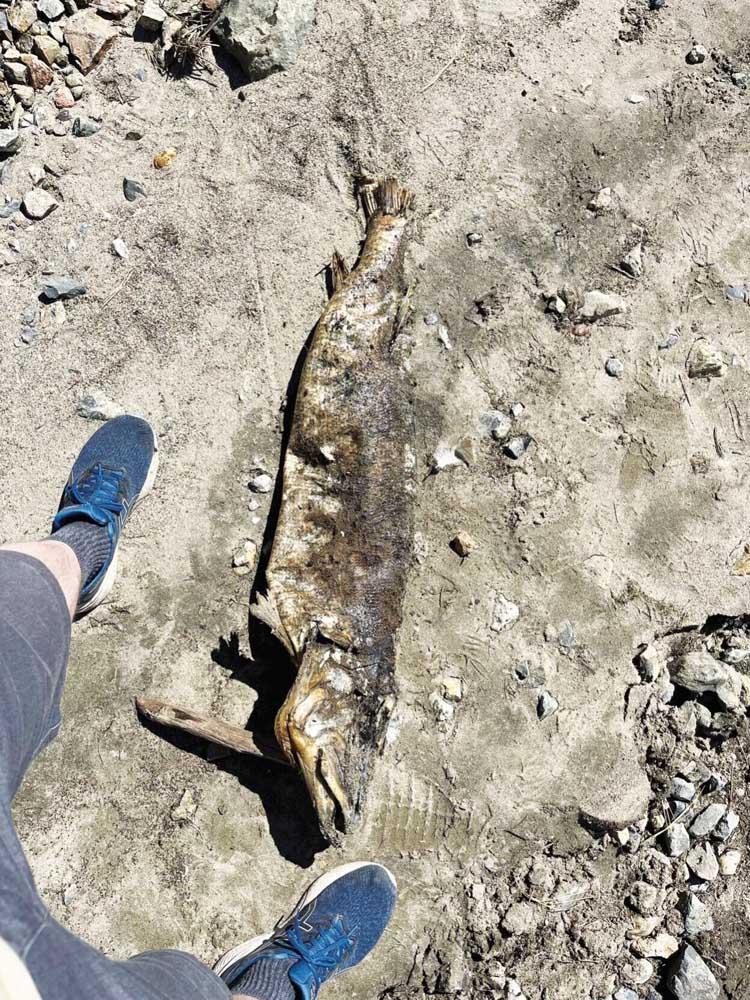Seeking to restore balance at Phillips Reservoir
Published 11:00 am Monday, September 2, 2024

- Ethan Brandt, a fish biologist from the Oregon Department of Fish and Wildlife, found this carcass of a 44-inch-long tiger muskie on the shore of Phillips Reservoir in late July 2024. ODFW released the sterile hybrid fish between 2013-16 with the hope the fish would eat yellow perch, which were illegally introduced in the reservoir about 30 years ago and have crowded out rainbow trout.
BAKER CITY — Ethan Brandt turned up some interesting results during the July 30 survey at Phillips Reservoir.
The fish biologist at the Oregon Department of Fish and Wildlife’s La Grande office said he netted two tiger muskies that were nearly a foot long.
ODFW released about 70,000 tiger muskies in the reservoir on April 23. Most of those fish were tiny, less than 1 inch long. About 10,000 were around an inch and a half long when released.
Brandt said although tiger muskies grow rapidly, he didn’t think any could have grown by 10 inches or so in just three months.
“That seems like an unusual growth rate,” he said. “They looked healthy.”
The tiger muskies, which are sterile hybrids that can’t reproduce, have a specific purpose — to eat yellow perch.
Since someone, who was never identified, illegally released perch in the reservoir more than 30 years ago, the spiny fish have had major effects on the fish population, and species, in the 2,250-acre reservoir about 17 miles southwest of Baker City.
Phillips, which was created by the construction of Mason Dam in 1968, was renowned for its rainbow trout for the first couple decades.
But the introduction of perch, which reproduce rapidly, eventually crowded out the trout, even though ODFW continues to stock hatchery-raised rainbow in the reservoir every year.
The number of angler visits at the reservoir dropped by about 90% compared to the pre-perch period.
Besides outcompeting trout, the perch reached such prodigious numbers — ODFW estimated there were around 1.5 million at times — the competition for the lake’s limited food resulted in stunted perch, with many adult fish 6 inches or shorter.
Because ODFW isn’t proposing to poison the reservoir — the only method that could conceivably eliminate perch — Brandt said the goal instead is to restore a species balance that yields better opportunities for anglers, whether they prefer to hook perch or trout.
Brandt said this spring that if even one half of one percent of the tiger muskies survive, “we should see some significant changes to the perch population in the coming years.”
Previous attempts to control perch
This spring’s release wasn’t the first time ODFW has stocked tiger muskies, a hybrid of the northern pike and the muskie, in Phillips to try to reduce the perch population.
Starting in 2013, and continuing for the next four years, the agency dumped 53,000 juvenile tiger muskies in the reservoir. Although the fish are sterile, ODFW biologists hoped their voracious appetite would thin the perch predominance.
But the experiment didn’t help much, Brandt said.
Many of the fish, which were about 5 inches long when released, were eaten by birds, Brandt said. Diving birds including terns, loons and mergansers, along with ospreys and other raptors, all feed on fish.
“These stockings were discontinued when it became clear that few of the fish were surviving,” according to an ODFW press release.
Brandt said some of the juvenile tiger muskies had radio trackers attached to a fin. More than half were eaten within a week or so, he said.
The tiger muskies released April 23, by contrast, are much smaller. Although larger fish, as well as birds, undoubtedly preyed on some of the minuscule tiger muskies, Brandt said ODFW tried to give the baby fish a boost by distributing them throughout the reservoir, but focusing on shoreline areas where copious grass should give the fish places to hide from predators.
Moreover, Brandt said diving birds had yet to arrive in large numbers in late April, so avian predation might not have posed a major threat to the tiger muskies until later in the spring.
He also hopes that because these fish were only in the hatchery for a short time, they will also be more wary of predators than tiger muskies that are raised longer in a hatchery.
The two nearly foot-long tiger muskies that he netted July 30 give Brandt reason to be optimistic.
He said most of the tiger muskies he netted were on the west side of the reservoir, near the dredge tailings.
ODFW plans to continue stocking the tiny muskies annually for at least five years. The fish were raised in a hatchery operated by the Utah Division of Wildlife Resources, which gave Oregon the fish for free.
During the July 31 survey, Brandt also found the carcass of a much larger tiger muskie on the reservoir’s shore. The fish was about 44 inches long, and must have been from one of the releases in the previous decade, he said.









